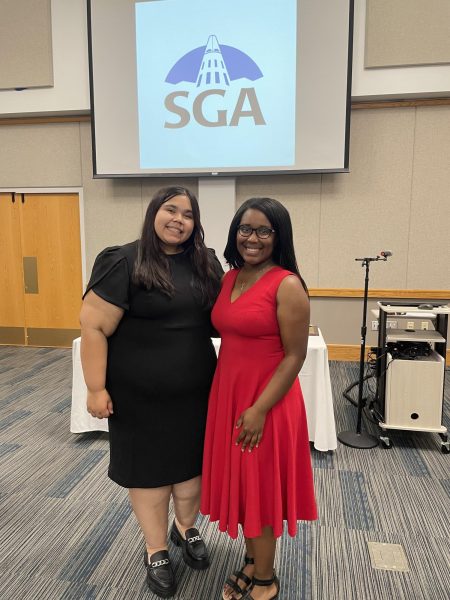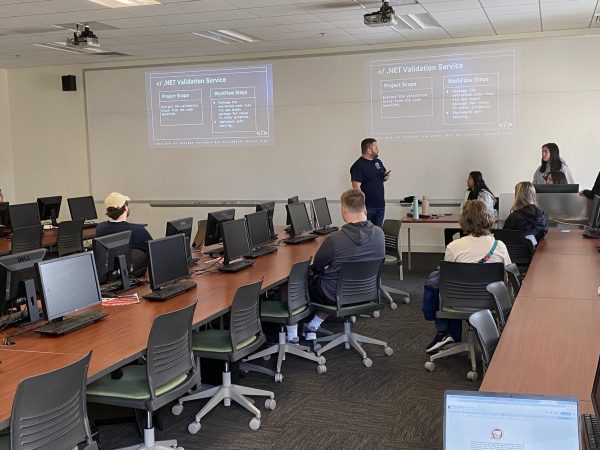USI professor studies informed consent on abortions
Assistant Professor of Gender Studies Grace Howard has been studying and working on reproductive law and policy since she was undergraduate in college.
She said she knew she wanted to continue her studies on the topic through graduate school at Rutgers University in New Brunswick, New Jersey.
“Around the time that I started graduate school, in 2011, there was this huge influx of legislative proposals in the states to regulate abortion,” Howard said. “This was, in part, driven by the Tea Party movement, many conservative lawmakers made limiting access to abortion a part of their legislative agenda.”
Howard is part of a research team that has studied and published an article on the state-mandated informed consent information given to patients seeking abortion.
Informed consent is what is given by a patient to a doctor for treatment with full knowledge of the possible risks and benefits. The process of informed consent occurs when communication between a patient and physician results in the patient’s authorization or agreement to undergo a specific medical intervention according to the American Medical Association.
“One of the things we knew about patients seeking abortion was that state-mandated informed consent may or may not be accurate, but also that often it is associated with a waiting period or an additional clinic visit.”
Howard has first-hand experience in the matter, having worked at an abortion clinic in Virginia.
“A lot of reproductive rights organizations are troubled because there are these laws forcing them to tell things to patients that are based on outdated studies and with research designs that are really questionable,” Howard said.
She said that prior to the study, many reproductive rights advocates were concerned that the content contained in these government-designed booklets was not scientific, including statements that having an abortion will give you breast cancer, or could cause mental health problems.
“The best research we have suggests that relief is the most commonly experienced emotional response to abortion,” she said. “We heard these things, and reproductive rights advocates and healthcare providers did not want to mislead their patients by distributing this inaccurate information, but no one had ever measured in a systematic way what is really in these informed consent booklets.”
The law varies by state.
“State-mandated informed consent looks different depending on what state you live in, it may include mandates to view certain printed materials, mandates to listen to the heart tones or to view an ultrasound, to wait 24 or 48 or 72 hours after getting the information, or to listen to a healthcare provider as they read a script to you that was written by government actors,” she said. “So we really wanted to measure what was being communicated to patients.”
Howard said that informed consent is an ancient, foundational part of good medical care, but typically, the content of that information is determined by medical professionals, not legislators.
“We collected all of the booklets the states were using for informed consent, and the bulk of what we focused on in these booklets is fetal development information,” she said.
Howard said there is a section about the risks associated with certain pregnancy outcomes, and often it’s just limited to information about the risks and side effects of various abortion procedures, excluding information about the risks of carrying a pregnancy to term and giving birth.
State-mandated informed consent booklets typically contain information about embryological or fetal development in two-week growth increments, and the study presented information about embryological or fetal development in two-week growth increments.
“It is not uncommon for states to borrow from one another, and sometimes different states would have identical booklets, which is fascinating. We consolidated statements where we needed to so that our volunteer reviewers wouldn’t have quite so many statements to look through,” she said.
Howard said they took out any identifying information about a state because they did not want to prejudice the panel of experts reviewing the information. She said maybe someone would assume that informed consent information from a southern state, or a state with a conservative reputation, would be more inaccurate.
The study began in 2012 and is ongoing.
“I think I was in my second year of grad school, and I got these informed consent statements and built the review survey, and one of the really big critiques of state-mandated informed consent was why are legislators telling people what medical information is relevant?” she said. “The same critique could apply to the authors of the study– we are political scientists, not human anatomists. So we decided to recruit a team of experts in human anatomy and embryological development.”
First, the research group added a team of recruits to survey almost 1,000 statements.
Howard said the team created two five-point scales for the anatomists to use when evaluating the materials– on a scale of true to false, and the other a scale of non-misleading to misleading.
“Informed consent is only constitutional if it is both true and non-misleading,” Howard said. “That’s the current legal standard. The people we recruited clicked through these hundreds of statements and gave their ratings using those scales.”
North Carolina and Michigan had the least accurate booklets, at 41 and 44 percent inaccurate respectively. Alaska was the most accurate with 14 percent of statements on fetal development rated as inaccurate.
“We used these two scales and then combined the ratings into an ‘accuracy/inaccuracy’ scale, because something can be technically true but highly misleading,” Howard said. “We saw a lot of that in the booklets. For example, a statement might read that ‘the brain is developing’ at two weeks. This is technically true, because the thing that will eventually become a brain is developing, but I don’t know that it gives a patient an accurate impression of the reality of neurological development at that period.”
Howard said the team included statements indicating fetal viability. Statements were grouped into different body systems within those two-week growth increments.
She said it was organized this way because it became clear that states were giving wildly divergent information to their patients, and that some of the information given by one state might contradict information given by another state, especially information about length and weight.
“The research team was also attentive to the attitudes held by the panel of anatomists, we were curious about whether certain attitudes would be associated with a tendency to rate statements as accurate or inaccurate,” she said. “To account for that, we did a follow-up survey inquiring about political ideology, religious beliefs, and attitudes about abortion. We did not find that their attitudes or beliefs had a statistically significant correlation with their evaluation.”
The study, published in 2016 at Duke University Press in the Journal of Health Politics, Policy and Law received a lot of press coverage at the time and came to three conclusions. First, nearly one-in-three statements about embryological development was medically inaccurate. It also discovered that the highest percentages of medical inaccuracy were found in the first trimester of pregnancy, when most women have an abortion.
The third finding found that inaccuracies were concentrated around certain body systems, such as extremities including arms, legs and fingers which overstated fetal development.
“After the study came out, we were contacted by some attorneys and some state departments of public health reached out to us,” Howard said.
She said when the study was published, many state health departments took notice and some expressed a desire to take swift action.
“Right after the study came out people in Departments of Health contacted us and said ‘hey look we are obligated by the law in our state to include a statement that was rated as inaccurate,’” Howard said. “But the law is really vague on what we need to include in this booklet and so we can change a lot of this stuff without involving the legislature or the courts at all.”
Once the inaccuracies in the booklets were showcased in the study, some states decided to change the wording of the informed consent booklets.
“I get the sense that’s what happened in Virginia,” she said. “The culmination of political pressure from the lawsuit and the exposure to this set things in motion.”
The Center for Reproductive Rights has challenged several states including Virginia and Indiana in the courts. The study, according to Howard, has been used in several lawsuits. In Virginia, a district court rejected a bid to halt a lawsuit against the state’s long-standing abortion restrictions.
The suit in Virginia is ongoing and Howard said the study was used to correct many of the inaccuracies in the old set of informed consent materials. A similar lawsuit is going down currently in Indiana.
“State-mandated informed consent for abortion is only allowed if it’s true and non-misleading and we have demonstrated not a single state has a booklet that is 100 percent true and non-misleading,” Howard said.
She said a strength of the study was that the work was done completely independently without the help of a grant provided by stakeholders that may have a political interest in the findings.
Howard said Indiana is one of the more hostile states to abortion access.
“It is pretty complex but this is a relatively conservative state with regard to the issue of abortion,” Howard said.“Leadership in Indiana has been very anti-abortion. (former Governor) Mike Pence has been notable for his anti-abortion stance, and it’s older than that, Indiana is a conservative place.”
Howard said though that Indiana’s consent booklet was not the worst.
“We know that in the states, especially in states with conservative legislatures, courts and an executive branch, that they are passing many restrictive laws,” she said.
Howard said, however, that the fetal development findings suggest to her that states are incapable of creating true and non-misleading informed consent booklets.
“When you read the statement of purpose in bills that make informed consent in a state, they are often predicated on this idea that the abortion providers are exploitative and women don’t really know what’s happening, they don’t understand pregnancy or birth or motherhood and that the state needs to step in and protect them and I think if that’s where you are walking in the door it’s going to be really hard to come up with a truly hard and unbiased booklet,” Howard said.
She said that she thinks informed consent for abortion should probably work the same way for how every medical procedure works.
“If we are going to force people to look at medical info the government tells them to look at we need to ensure it is as truthful as possible,” Howard said. “Even if you are someone who doesn’t support abortion you could probably agree to the idea of your doctor being forced to tell you things that are not true is kind of a problem.”
She said the study showed that depending on where you live, if you have been exposed to this information you could come out with less of an idea of what’s accurate then when you started.
“Spreading misinformation is the opposite of what (informed consent) is supposed to do,” she said. “I don’t know what will happen with the legality of abortion, but if we are going to have state-mandated informed consent for abortion, I would like the law to be functioning in a constitutional way, aside from the implicit stuff about making people feel guilty or frightened about their healthcare decisions.”










